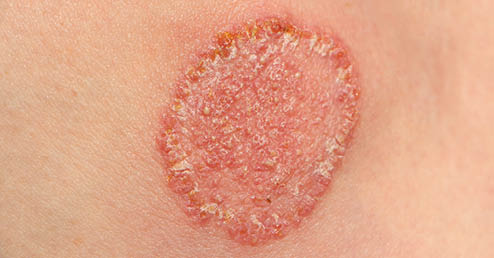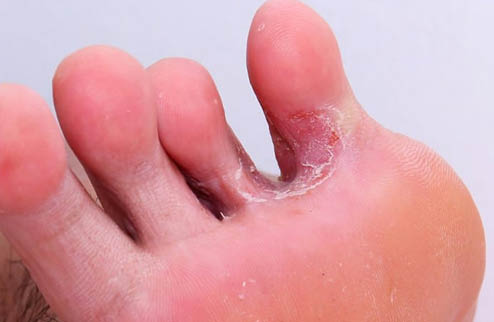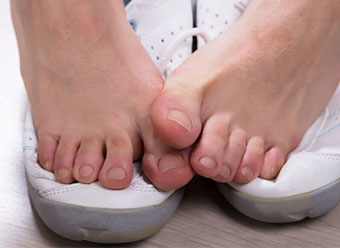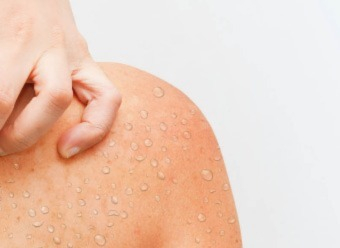Cutaneous mycoses are fungal infections of the skin caused by microscopic fungi.
They can affect different parts of the body, such as the trunk, the scalp, the mucous membranes or more commonly the foot and the nails.
Candida, Dermatophytes and Malassezia are the fungi implicated in fungal cutaneous infections: symptoms, causes, treatments, identifying them is the first step towards healing.
The different types of cutaneous mycoses: cutaneous dermatophytia and pityriasis versicolor
Dermatophyte mycoses of the skin are microscopic fungi that can cause skin infections in humans and animals.
Cutaneous mycosis caused by dermatophytes can take different forms, such as ringworm (mycosis of the scalp and hair), nail mycosis and athlete's foot. They are generally transmitted by direct contact with an infected person or animal, or by self-contamination from an infectious focus, often of the feet.
Dermatophyte lesions on the skin are usually round, well demarcated, and have a red, finely scaly edge.
Affected areas may contain blisters or pustules.
These lesions often extend peripherally leaving a central healing area.
Embarrassing, the itching can be very intense.

Malassezia, on the other hand, is a fungus responsible for pityriasis versicolor of the skin (or Tinea Versicolor), a common skin infection. This fungus, naturally found on most people's skin, can grow excessively and cause uncomfortable symptoms in specific areas such as the torso, neck and arms, and sometimes on the head and face.
More common in adolescents and young adults, pityriasis versicolor is often caused by high temperatures and humidity. Symptoms of this skin infection include the appearance of white or brown patches on the skin, itching, scaling and redness.
These patches are usually well defined and can cover a large area of the body. Note that the spots generally become white on the skin pigmented by the sun (hence the term versicolor to describe this mycosis of the skin and the sun). Pityriasis versicolor is not contagious and does not itch.

Finally, Candida albicans is a yeast that can cause skin infections in the skin folds, also known as intertrigo.
This cutaneous mycosis is often caused by high temperatures and moisture in the skin folds, creating a favourable environment for yeast growth. Symptoms can include redness, itching and pain, as well as the formation of cracks and scabs.

How do you catch mycosis of the skin?
Here are the possible causes of the cutaneous mycoses mentioned:
● For dermatophyte mycosis of the skin, in direct contact with an infected person or animal. Pityriasis versicolor and candida are not considered contagious pathologies.
● Contact with infected surfaces (such as floors and showers) for dermatophytosis only
● Excessive perspiration, which creates a warm, humid environment conducive to fungal growth
● Immunodeficiency, such as from HIV or taking immunosuppressive medicines
● Certain underlying diseases such as diabetes, obesity or vascular disease
● Trauma to the skin (such as insect bites) that create openings for fungi
● Wearing tight clothes or closed shoes that prevent the skin from breathing and create an environment conducive to the proliferation of fungi
● A lack of personal hygiene, including insufficient cleaning of the skin.
Healing time for cutaneous mycosis
The duration of cutaneous mycosis varies depending on the type of infection, the area affected and the general health of the infected person. In some cases, skin infections may go away on their own, but in most cases, treatment is needed to clear up the infection. It is important to see a doctor if the infection does not go away after a few weeks of home treatment.
Treatment of mycosis of the skin
Topical treatments such as antifungal creams are often used for mild infections, while more severe skin infections may require oral antifungal medications.
Hygiene products such as gentle cleansing gels dedicated to skin prone to mycosis are useful in the event of the appearance of infections and to protect against recurrences.
Always remember to consult your dermatologist or pharmacist to diagnose and determine the most appropriate treatment for each type of infection.
Sources :
● Assurance Maladie, Reconnaître une mycose cutanée, 2021.
● Le Manuel MSD, Présentation des infections mycosiques de la peau, 2021.





